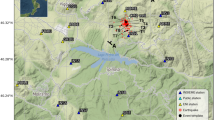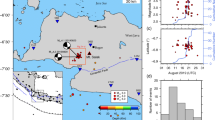Abstract
Over the past decade, Oklahoma became the most seismically active region of the mid-Continental USA as a result of industry operations. However, seismic network limitations and completeness of earthquake catalogs have restricted the types of analyses that can be performed. By applying multi-station template matching on the 23,889 cataloged earthquakes in Oklahoma and Southern Kansas between late-2008 and 2016, we increased the number of detected earthquakes to 209,409 events. While the improved catalog produced an order of magnitude events than the original catalog, the frequency-magnitude distribution remains similar to the original catalog. We found that the coefficient of variation of interevent times in small spatial bins tends to spatially correlate with the location of M ≥ 4 earthquakes. The improved catalog reveals the pervasiveness of swarm-like patterns in seismicity across the entire study region. The rapid increase in seismicity rate of these swarms in 2013 coincided with a reduction in the calculated p values (power law decay rates) before and after larger events. We also used the catalog to revisit the temporal patterns in the four M ≥ 5 sequences, finding more active foreshock behavior than previously recognized and variations in aftershock behavior. When compared against poroelastic stress models for the Pawnee and Fairview sequences, the catalog shows an improved correlation with stress that accounts for variable-rate injection, supporting the conclusion that injection rate is an important contributor to seismic hazard.











Similar content being viewed by others
References
Aki K (1965) Maximum likelihood estimate of b in the formula log N = a - bM and its confidence limits. Bull Earthq Res Inst Univ Tokyo 43:237–239
Barbour AJ, Norbeck JH, Rubinstein JL (2017) The effects of varying injection rates in Osage County, Oklahoma, on the 2016 mw 5.8 Pawnee earthquake. Seismol Res Lett 88(5):1040–1053
Chen X, Nakata N, Pennington C, Haffener J, Chang JC, He X, Zhan Z, Ni S, Walter JI (2017) The Pawnee earthquake as a result of the interplay among injection, faults and foreshocks. Sci Rep 7(1):4945
Cochran ES, Ross ZE, Harrington RM, Dougherty SL, Rubinstein JL (2018) Induced earthquake families reveal distinctive evolutionary patterns near disposal wells. J Geophys Res Solid Earth 123:8045–8055. https://doi.org/10.1029/2018JB016270
Deng K, Liu Y, Harrington RM (2016) Poroelastic stress triggering of the December 2013 crooked Lake, Alberta, induced seismicity sequence. Geophys Res Lett 43:8482–8491
Ellsworth WL (2013) Injection-induced earthquakes. Science 341:1225942. https://doi.org/10.1126/science.1225942
Ellsworth WL, Llenos AL, McGarr AF, Michael AJ, Rubinstein JL, Mueller CS, Petersen MD, Calais E (2015) Increasing seismicity in the US midcontinent: implications for earthquake hazard. Lead Edge 34(6):618–626
Goebel THW, Weingarten M, Chen X, Haffener J, Brodsky EE (2017) The 2016 Mw5. 1 Fairview, Oklahoma earthquakes: evidence for long-range poroelastic triggering at > 40 km from fluid disposal wells. Earth Planet Sci Lett 472:50–61
Gutenberg B, Richter CF (1944) Frequency of earthquakes in California. Bull Seismol Soc Am 34(4):185–188
Haffener J, Chen X, Murray K (2018) Multiscale analysis of spatiotemporal relationship between injection and seismicity in Oklahoma. J Geophys Res Solid Earth 123(10):8711–8731
Healy JH, Rubey WW, Griggs DT, Raleigh CB (1968) The Denver earthquakes. Science 161:1301–1310
Hincks T, Aspinall W, Cooke R, Gernon T (2018) Oklahoma's induced seismicity strongly linked to wastewater injection depth. Science 359(6381):1251–1255
Holtkamp SG, Brudzinski MR (2011) Earthquake swarms in circum-Pacific subduction zones. Earth Planet Sci Lett 305(1–2):215–225
Horton S (2012) Disposal of hydrofracking waste fluid by injection into subsurface aquifers triggers earthquake swarm in Central Arkansas with potential for damaging earthquake. Seismol Res Lett 83:250–260. https://doi.org/10.1785/gssrl.83.2.250
Kagan YY, Jackson DD (1991) Long-term earthquake clustering. Geophys J Int 104(1):117–134. https://doi.org/10.1111/j.1365-246X.1991.tb02498.x
Keranen KM, Savage HM, Abers GA, Cochran ES (2013) Potentially induced earthquakes in Oklahoma, USA: links between wastewater injection and the 2011 mw 5.7 earthquake sequence. Geology 41(6):699–702
Keranen KM, Weingarten M, Abers GA, Bekins BA, Ge S (2014) Sharp increase in Central Oklahoma seismicity since 2008 induced by massive wastewater injection. Science 345(6195):448–451
Langenbruch C, Zoback MD (2016) How will induced seismicity in Oklahoma respond to decreased saltwater injection rates. Sci Adv 2(11):e1601542. https://doi.org/10.1126/sciadv.1601542
Marsh SM and Holland AA (2016). Comprehensive fault database and interpretive fault map of Oklahoma. Oklahoma Geological Survey Open File Report OF2–2016
Massey FJ Jr (1951) The Kolmogorov-Smirnov test for goodness of fit. J Am Stat Assoc 46(253):68–78
McGarr A, Barbour AJ (2017) Wastewater disposal and the earthquake sequences during 2016 near Fairview, Pawnee, and Cushing, Oklahoma. Geophys Res Lett 44(18):9330–9336
McGarr A, Bekins B, Burkardt N, Dewey J, Earle P, Ellsworth W, Ge S, Hickman S, Holland A, Majer E, Rubinstein J (2015) Coping with earthquakes induced by fluid injection. Science 347(6224):830–831
McNamara DE, Hayes GP, Benz HM, Williams RA, McMahon ND, Aster RC, Holand A, Sickbert T, Herrmann R, Briggs R, Smoczyk G, Bergman E, Earle P (2015a) Reactivated faulting near Cushing, Oklahoma: increased potential for a triggered earthquake in an area of United States strategic infrastructure. Geophys Res Lett 42(20):8328–8332
McNamara DE, Rubinstein JL, Myers E, Smoczyk G, Benz HM, Williams RA, Hayes G, Wilson DC, Herrmann RB, McMahon ND, Aster RC, Bergman E, Holland A, Earle P (2015b) Efforts to monitor and characterize the recent increasing seismicity in Central Oklahoma. Lead Edge 34(6):628–639
Miller LH (1956) Table of percentage points of Kolmogorov statistics. J Am Stat Assoc 51(273):111–121
Petersen MD, Mueller CS, Moschetti MP, Hoover SM, Shumway AM, McNamara DE, Williams R, Llenos AL, Ellsworth WL, Rubinstein JL, McGarr AF, Rukstales KS (2017) 2017 one-year seismic-hazard forecast for the central and eastern United States from induced and natural earthquakes. Seismol Res Lett 88(3):772–783
Rubinstein JL, Ellsworth WL, Dougherty SL (2018a) The 2013 – present induced earthquake sequence in southern Kansas. Bull Seismol Soc Am 108:674–689. https://doi.org/10.1785/0120170209
Rubinstein JL, Ellsworth WL, Dougherty SL (2018b) The 2013–2016 induced earthquakes in Harper and Sumner counties, southern Kansas. Bull Seismol Soc Am 108(2):674–689
Schaff DP (2008) Semiempirical statistics of correlation-detector performance: bull. Seismol Soc Am 98:1495–1507. https://doi.org/10.1785/0120060263
Schaff DP, Waldhauser F (2005) Waveform cross-correlation-based differential travel-time measurements at the northern California seismic network. Bull Seismol Soc Am 95(6):2446–2461
Schoenball M, Ellsworth WL (2017) A systematic assessment of the spatiotemporal evolution of fault activation through induced seismicity in Oklahoma and southern Kansas. J Geophys Res Solid Earth 122:10,189–10,206. https://doi.org/10.1002/2017JB014850
Shelly DR, Beroza GC, Ide S (2007) Non-volcanic tremor and low-frequency earthquake swarms. Nature 446(7133):305–307
Skoumal RJ, Brudzinski MR, Currie BS, Levy J (2014) Optimizing multi-station earthquake template matching through re-examination of the Youngstown Ohio, sequence. Earth Planet Sci Lett 405:274–280. https://doi.org/10.1016/j.epsl.2014.08.033
Skoumal RJ, Brudzinski MR, Currie BS (2015a) Earthquakes induced by hydraulic fracturing in Poland township, Ohio. Bull Seismol Soc Am 105(1):189–197. https://doi.org/10.1785/0120140168
Skoumal RJ, Brudzinski MR, Currie BS (2015b) Distinguishing induced seismicity from natural seismicity in Ohio: demonstrating the utility of waveform template matching. J Geophys Res Solid Earth 120:6284–6296. https://doi.org/10.1002/2015JB012265
Skoumal RJ, Brudzinski MR, Currie BS (2016) An efficient repeating signal detector to investigate earthquake swarms. J Geophys Res 121:5880–5897. https://doi.org/10.1002/2016JB012981
Skoumal RJ, Ries R, Brudzinski MR, Barbour AJ, Currie BS (2018a) Earthquakes induced by hydraulic fracturing are pervasive in Oklahoma. J Geophys Res Solid Earth 123:10,918–10,935. https://doi.org/10.1029/2018JB016790
Skoumal RJ, Brudzinski M, Currie B (2018b) Proximity of Precambrian basement affects the likelihood of induced seismicity in the Appalachian, Illinois, and Williston basins. Geosphere 14(3):1365–1379. https://doi.org/10.1130/GES01542.1
Skoumal RJ, Kaven J, Walter J (2019) Characterizing seismogenic fault structures in Oklahoma using a relocated template matched catalog. Seismol Res Lett 90(4):1535–1543. https://doi.org/10.1785/0220190045
Sumy DF, Cochran ES, Keranen KM, Wei M, Abers GA (2014) Observations of static coulomb stress triggering of the November 2011 M5. 7 Oklahoma earthquake sequence. J Geophys Res Solid Earth 119(3):1904–1923. https://doi.org/10.1002/2013JB010612
Trabant C, Hutko AR, Bahavar M, Karstens R, Ahern T, Aster R (2012) Data products at the IRIS DMC: stepping stones for research and other applications. Seismol Res Lett 83(5):846–854. https://doi.org/10.1785/0220120032
Utsu T, Ogata Y, Matsu'ura RS (1995) The centenary of the Omori formula for a decay of aftershock activity. J Phys Earth 43:1–33
Van der Elst NJ, Savage HM, Keranen KM, Abers GA (2013) Enhanced remote earthquake triggering at fluid-injection sites in the midwestern United States. Science 341(6142):164–167
Vidale JE & Shearer PM (2006). A survey of 71 earthquake bursts across southern California: exploring the role of pore fluid pressure fluctuations and aseismic slip as drivers. Journal of Geophysical Research: Solid Earth, 111
Walsh FR, Zoback MD (2015) Oklahoma’s recent earthquakes and saltwater disposal. Sci Adv 1(5):e1500195
Walter JI, Dotray PJ, Frohlich C, Gale JF (2016) Earthquakes in Northwest Louisiana and the Texas–Louisiana border possibly induced by energy resource activities within the Haynesville shale play. Seismol Res Lett 87(2a):285–294. https://doi.org/10.1785/0220150193
Walter JI, Chang JC, Dotray PJ (2017a) Foreshock seismicity suggests gradual differential stress increase in the months prior to the 3 September 2016 M w 5.8 Pawnee earthquake. Seismol Res Lett 88(4):1032–1039
Walter JI, Chang JC, Dotray PJ (2017b) Foreshock seismicity suggests gradual differential stress increase in the months prior to the 3 September 2016 mw 5.8 Pawnee earthquake. Seismol Res Lett 88(4):1032–1039. https://doi.org/10.1785/0220170007
Weingarten M, Ge S, Godt JW, Bekins BA, Rubinstein JL (2015) High-rate injection is associated with the increase in US mid-continent seismicity. Science 348(6241):1336–1340
Wiemer S, Wyss M (2000) Minimum magnitude of completeness in earthquake catalogs: examples from Alaska, the Western United States, and Japan. Bull Seismol Soc Am 90(4):859–869
Woessner J, Wiemer S (2005) Assessing the quality of earthquake catalogues: estimating the magnitude of completeness and its uncertainty. Bull Seismol Soc Am 95(2):684–698
Yeck WL, Sheehan AF, Benz HM, Weingarten M, Nakai J (2016a) Rapid response, monitoring, and mitigation of induced seismicity near Greeley, Colorado. Seismol Res Lett 87(4):837–847
Yeck WL, Weingarten M, Benz HM, McNamara DE, Bergman EA, Herrmann RB, Rubinstein JL, Earle PS (2016b) Far-field pressurization likely caused one of the largest injection induced earthquakes by reactivating a large preexisting basement fault structure. Geophys Res Lett 43(19):10–198
Yeck WL, Hayes GP, McNamara DE, Rubinstein JL, Barnhart WD, Earle PS, Benz HM (2017) Oklahoma experiences largest earthquake during ongoing regional wastewater injection hazard mitigation efforts. Geophys Res Lett 44(2):711–717
Yoon C, O’Reilly O, Bergen K, Beroza G (2015) Earthquake detection through computationally efficient similarity search. Sci Adv 1:e1501057
Zhang Y, Person M, Rupp J, Ellett K, Celia MA, Gable CW, Bowen B, Evans J, Bandilla K, Mozley P, Dewers T (2013) Hydrogeologic controls on induced seismicity in crystalline basement rocks due to fluid injection into basal reservoirs. Groundwater 51(4):525–538
Acknowledgments
All waveform data were obtained through the Incorporated Research Institutions for Seismology Data Management Center (IRIS) (www.iris.edu; last accessed April 2017). Earthquake catalogs were obtained from the U.S. Geological Survey (USGS) National Earthquake Information Center (NEIC) (http://earthquake.usgs.gov/data; last accessed April 2017) and the Oklahoma Geological Survey (http://www.ou.edu/ogs.html; last accessed April 2017). Well data were retrieved from FracFocus (https://fracfocus.org; last accessed April 2017). This research benefited from discussions with A. Barbour, E. Cochran, H. DeShon, W. Ellsworth, P. Friberg, O. Kaven, A. Michael, J. Norbeck, W. Rish, J. Rubinstein, D. Shelly, and D. Sumy. This manuscript was improved thanks to G. Beroza, R. Habiger, A. Holland, A. McGarr, J. Rubinstein, and J. Shemeta. Our analysis relied heavily on Miami University’s High Performance Computing, and we thank B. Koby and J. Mueller for their assistance.
Funding
Support for this work was provided by NSF (EAR-0847688) and USGS NEHRP (2015-0176, 2016-0124).
Author information
Authors and Affiliations
Corresponding author
Additional information
Publisher’s note
Springer Nature remains neutral with regard to jurisdictional claims in published maps and institutional affiliations.
Highlights
•We increased the number of cataloged earthquakes in Oklahoma between 2008 and 2016 by roughly an order of magnitude
•This improved catalog allows individual sequences and regional seismicity patterns to be analyzed in greater detail
•We find more foreshock activity prior to M ≥ 5 earthquakes, pervasive swarminess, and high coefficients of variation
Rights and permissions
About this article
Cite this article
Skoumal, R.J., Brudzinski, M.R., Currie, B.S. et al. Temporal patterns of induced seismicity in Oklahoma revealed from multi-station template matching. J Seismol 24, 921–935 (2020). https://doi.org/10.1007/s10950-019-09864-9
Received:
Accepted:
Published:
Issue Date:
DOI: https://doi.org/10.1007/s10950-019-09864-9




